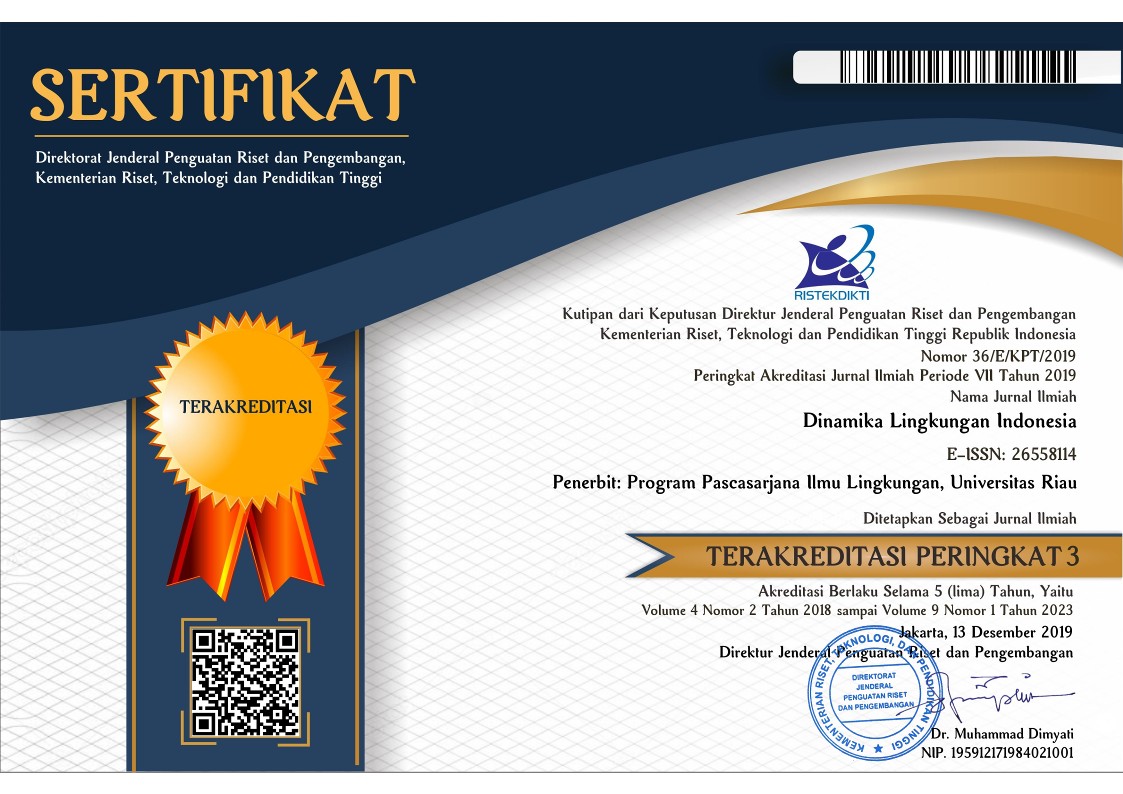Analisa Pemetaan Kawasan Rawan Banjir di Kabupaten Kampar
Abstract
Kampar District is traversed by two large rivers and several small rivers, including Kampar River which is ± 413.5 km long with an average depth of 7.7 m, and an average width of 143 m. Referring to Central Statistics Agency Kampar Regency (2015), Kampar residents numbered 703,005 people with a growth of 2.57% that exceeded the national population growth in 2010 of 1.49%. The Kampar Kanan River has a much larger flood impact than Kampar Kiri River because the majority of the population lives along the banks of the Kampar Kanan River. Areas that are always targeted need to be mapped in the form of flood vulnerability maps within Kampar regency. To map areas susceptible to flooding in Kampar District can be done using remote sensing data based on Geographic Information System (GIS). Analysis of the overlay map results as an indicator of flooding in 4 flood vulnerability classes in Kampar regency. Overlaid maps consist of Rainfall Map, Slope Map, Land Use Map and Geological Map, which resulted in the widest area in Kampar District in the prone category of 459,977.89 ha or 42.86% of the district area. The second sequence is in the non-vulnerable category 236,082.39 ha or 22.00%. While the order of the 3rd area is in very vulnerable category that is 219.279.54 ha or 20.43%, and the smallest area is in the safe category of 157,835.01 ha or 14.71% of Kampar Regency area.
Keywords
Full Text:
PDFReferences
Abidin, H.Z. (2002). Survei Dengan Global Position System (GPS). PT Pradnya Pramita. Jakarta.
Asdak, C. 2010. Hidrologi dan pengelolaan Dearah Aliran Sungai. Gajah Mada University Press. Yogyakarta.
BPS Kabupaten Kampar. 2016. Kampar dalam angka. Badan Pusat Statistik Kabupaten Kampar. Bangkinang.
Charter, D (2004) Mapinfo professional, Informatika Bandung, Bandung.
Darmawan, K., Hani’ah, dan A. Suprayogi. 2017. Analisis tingkat kerawanan banjir di Kabuapten Sampang menggunakan metode overlay dengan scoring berbasis system informasi geografis. Jurnal Geodesi.
Ekadinata, A. Sonya, D. Danan, P. H. Dudy dan K. N. Feri. 2008. Sistem inormasi geografis : Untuk pengelolaan bentang lahan berbasis sumber daya alam. World Agrofprestry Centtre. Bogor.
Elly, M. J. 2009. Sistem informasi geografi menggunakan aplikasi ArcView 3.2 dan Ermapper 6.4. Graha Ilmu, Yogyakarta.
Hamdani, H., S. Permana, A. Susetyaningsih. 2014. Analisis daerah rawan banjir menggunakan aplikasi system informasi geografis (Stusi kasus Pulau Bangka). Jurnal STT-Garut Allright Reserved. 12 (1) : 1 – 13.
Haryani, N. S. 2008. Model simulasi banjir menggunakan data penginderaan jauh (Studi kasus Kabupaten Sampang menggunakan metode gredded surface sub-surface hidrologic analisys). Jurnal Penginderaan Jauh. 9 (2) : 90- 101.
Media Center. 2014. Banjir Kmapar ditetapkan sebagai daerah tangkap darurat bajir. http://www.mediacenter.or.id/reports/view/876#.WI2rIVJWVqM 29 Januari 2017, Pukul 16.57 WIB.
Nurdin. 2015. Pemetaan kawasan rentan banjir dalam Kota Pekanbaru menggunakan sistem informasi geografis. Prosiding Seminar Nasional Teknik Sipil (Annual Civil Engineering Seminar 2015). Pekanbaru.
Profil Kabupaten Kampar. 2017. Geografis. http://kamparkab.go.id/page/geografis
Raharjo, P. D., A. M. Nur, dan E. Hidayat. 2011. Aplikasi system informasi geografis dalam mengidentifikasi kerawanan bencana alam di kawasan cagar alam geologi Karangsambung. Buletin Geologi Tata Lingkungan (Bulletin of Environmental Geology).21(1) : 23 – 33.
Rahmat, B. 2016. Banjir Kampar telan dua korban jiwa. http:pekanbaru.tribunnews.com/2016/02/11/banjir-kampar-telan-dua-korban-jiwa. 27 Januari 2017, Pukul 17.43 WIB.
Sukiyah, E. 2004. Aplikasi Sistem Informasi Geografis dalam Penetapan Kawasan Rawan Banjir di Kabupaten Bandung Bagian Selatan. Bulletin of Scientific Contribution. 2 (1) : 26-37.
Sukojo, B.M. 2005. Penyiapan Sumber Manusia Untuk Menunjang Pembangunan Informasi Spasial di Institut Teknologi Sepuluh November (Its) Surabaya, Pertemuan Ilmiah Tahunan MAPIN XIV. Surabaya.
Prahasta, E. 2001. Konsep-konsep dasar sistem informasi geografis. Bandung: Informatika. Profil Kabupaten Kampar. 2017. Geografis. http://kamparkab.go.id/page/geografis.
DOI: http://dx.doi.org/10.31258/dli.5.2.p.108-114
Refbacks
- There are currently no refbacks.





